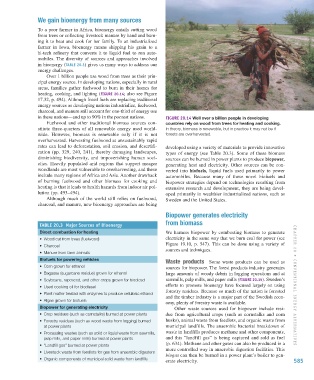Page 586 - Environment: The Science Behind the Stories
P. 586
We gain bioenergy from many sources
To a poor farmer in Africa, bioenergy entails cutting wood
from trees or collecting livestock manure by hand and burn-
ing it to heat and cook for her family. To an industrialized
farmer in Iowa, bioenergy means shipping his grain to a
hi-tech refinery that converts it to liquid fuel to run auto-
mobiles. The diversity of sources and approaches involved
in bioenergy (TABLE 20.3) gives us many ways to address our
energy challenges.
Over 1 billion people use wood from trees as their prin-
cipal energy source. In developing nations, especially in rural
areas, families gather fuelwood to burn in their homes for
heating, cooking, and lighting (FIGURE 20.14; also see Figure
17.32, p. 494). Although fossil fuels are replacing traditional
energy sources as developing nations industrialize, fuelwood,
charcoal, and manure still account for one-third of energy use
in these nations—and up to 90% in the poorest nations. FIGURE 20.14 Well over a billion people in developing
Fuelwood and other traditional biomass sources con- countries rely on wood from trees for heating and cooking.
stitute three-quarters of all renewable energy used world- In theory, biomass is renewable, but in practice it may not be if
wide. However, biomass is renewable only if it is not forests are overharvested.
overharvested. Harvesting fuelwood at unsustainably rapid
rates can lead to deforestation, soil erosion, and desertifi- developed using a variety of materials to provide innovative
cation (pp. 329, 240, 241), thereby damaging landscapes, types of energy (see Table 20.3). Some of these biomass
diminishing biodiversity, and impoverishing human soci- sources can be burned in power plants to produce biopower,
eties. Heavily populated arid regions that support meager generating heat and electricity. Other sources can be con-
woodlands are most vulnerable to overharvesting, and these verted into biofuels, liquid fuels used primarily to power
include many regions of Africa and Asia. Another drawback automobiles. Because many of these novel biofuels and
of burning fuelwood and other biomass for cooking and biopower strategies depend on technologies resulting from
heating is that it leads to health hazards from indoor air pol- extensive research and development, they are being devel-
lution (pp. 493–494). oped primarily in wealthier industrialized nations, such as
Although much of the world still relies on fuelwood, Sweden and the United States.
charcoal, and manure, new bioenergy approaches are being
Biopower generates electricity
from biomass
TABLE 20.3 Major Sources of Bioenergy
Direct combustion for heating We harness biopower by combusting biomass to generate
• Wood cut from trees (fuelwood) electricity in the same way that we burn coal for power (see
• Charcoal Figure 19.10, p. 547). This can be done using a variety of
sources and techniques.
• Manure from farm animals
Biofuels for powering vehicles
Waste products Some waste products can be used as
• Corn grown for ethanol sources for biopower. The forest products industry generates
• Bagasse (sugarcane residue) grown for ethanol large amounts of woody debris in logging operations and at
• Soybeans, rapeseed, and other crops grown for biodiesel sawmills, pulp mills, and paper mills (FIGURE 20.15). Sweden’s
• Used cooking oil for biodiesel efforts to promote bioenergy have focused largely on using CHAPTER 20 • CONVENTI ON AL ENERGY ALTERN ATIVES
• Plant matter treated with enzymes to produce cellulosic ethanol forestry residues. Because so much of the nation is forested
and the timber industry is a major part of the Swedish econ-
• Algae grown for biofuels omy, plenty of forestry waste is available.
Biopower for generating electricity Other waste sources used for biopower include resi-
• Crop residues (such as cornstalks) burned at power plants due from agricultural crops (such as cornstalks and corn
• Forestry residues (such as wood waste from logging) burned husks), animal waste from feedlots, and organic waste from
at power plants municipal landfills. The anaerobic bacterial breakdown of
• Processing wastes (such as solid or liquid waste from sawmills, waste in landfills produces methane and other components,
pulp mills, and paper mills) burned at power plants and this “landfill gas” is being captured and sold as fuel
• “Landfill gas” burned at power plants (p. 634). Methane and other gases can also be produced in a
more controlled way in anaerobic digestion facilities. This
• Livestock waste from feedlots for gas from anaerobic digesters
biogas can then be burned in a power plant’s boiler to gen-
• Organic components of municipal solid waste from landfills
erate electricity. 585
M20_WITH7428_05_SE_C20.indd 585 13/12/14 1:56 PM

